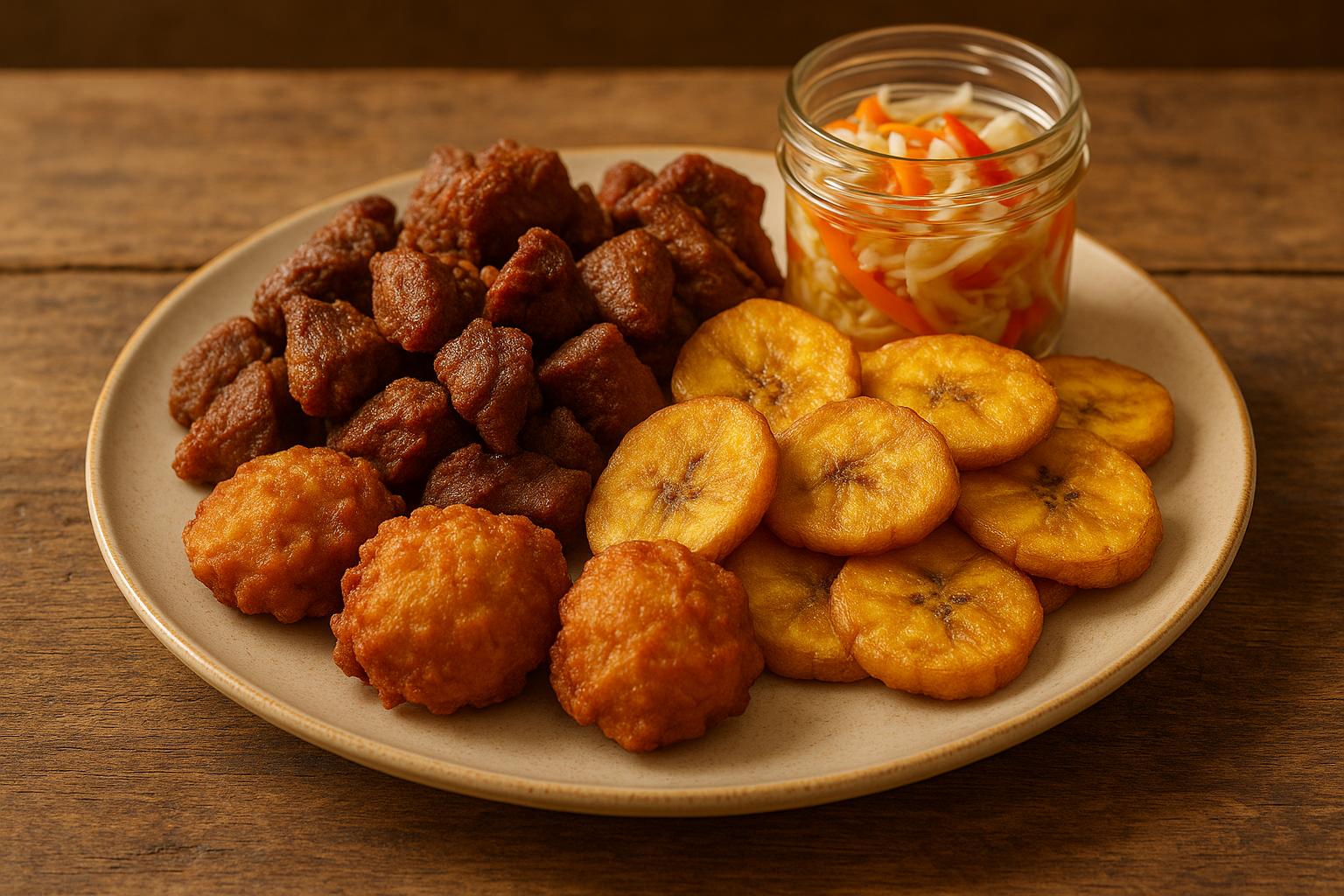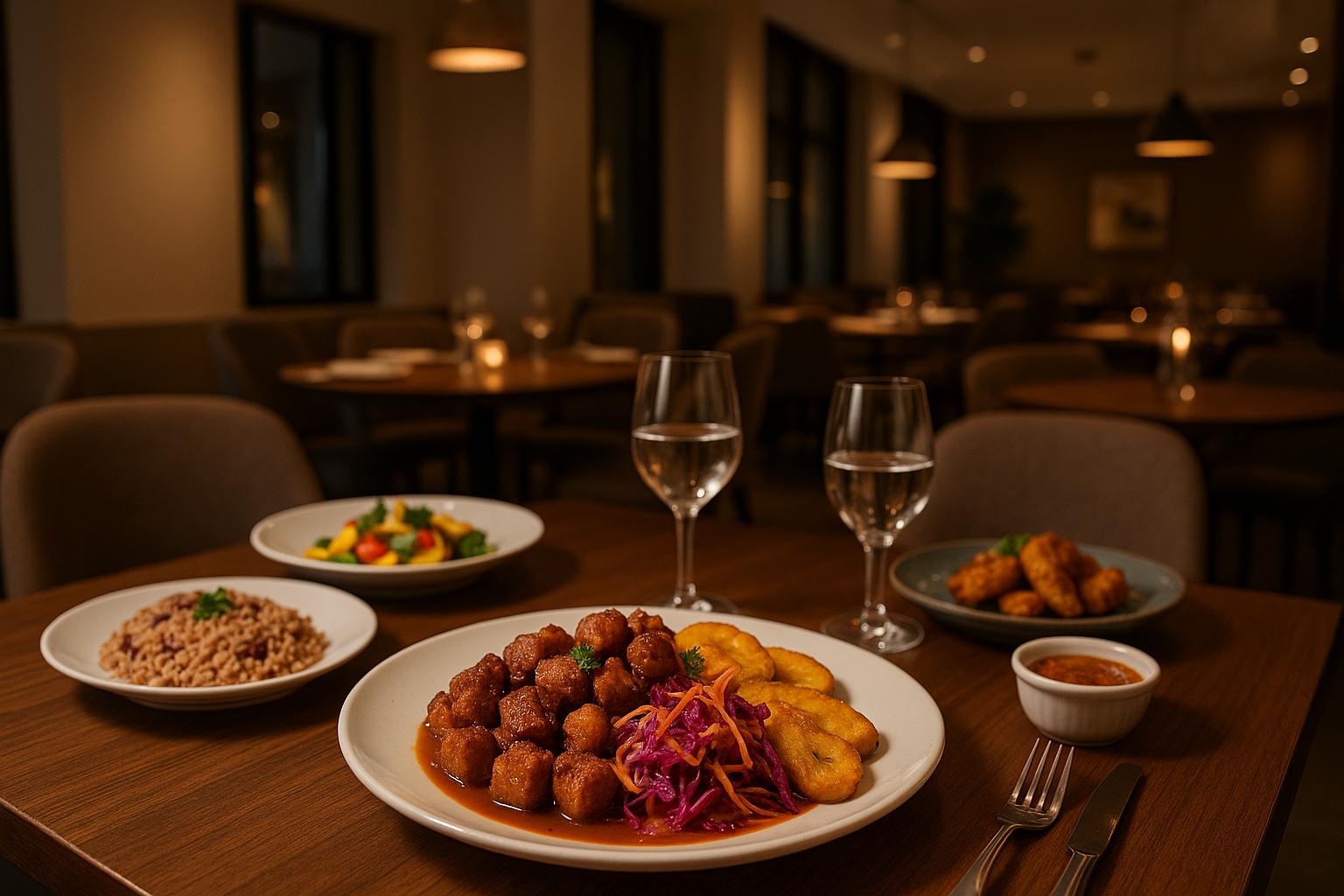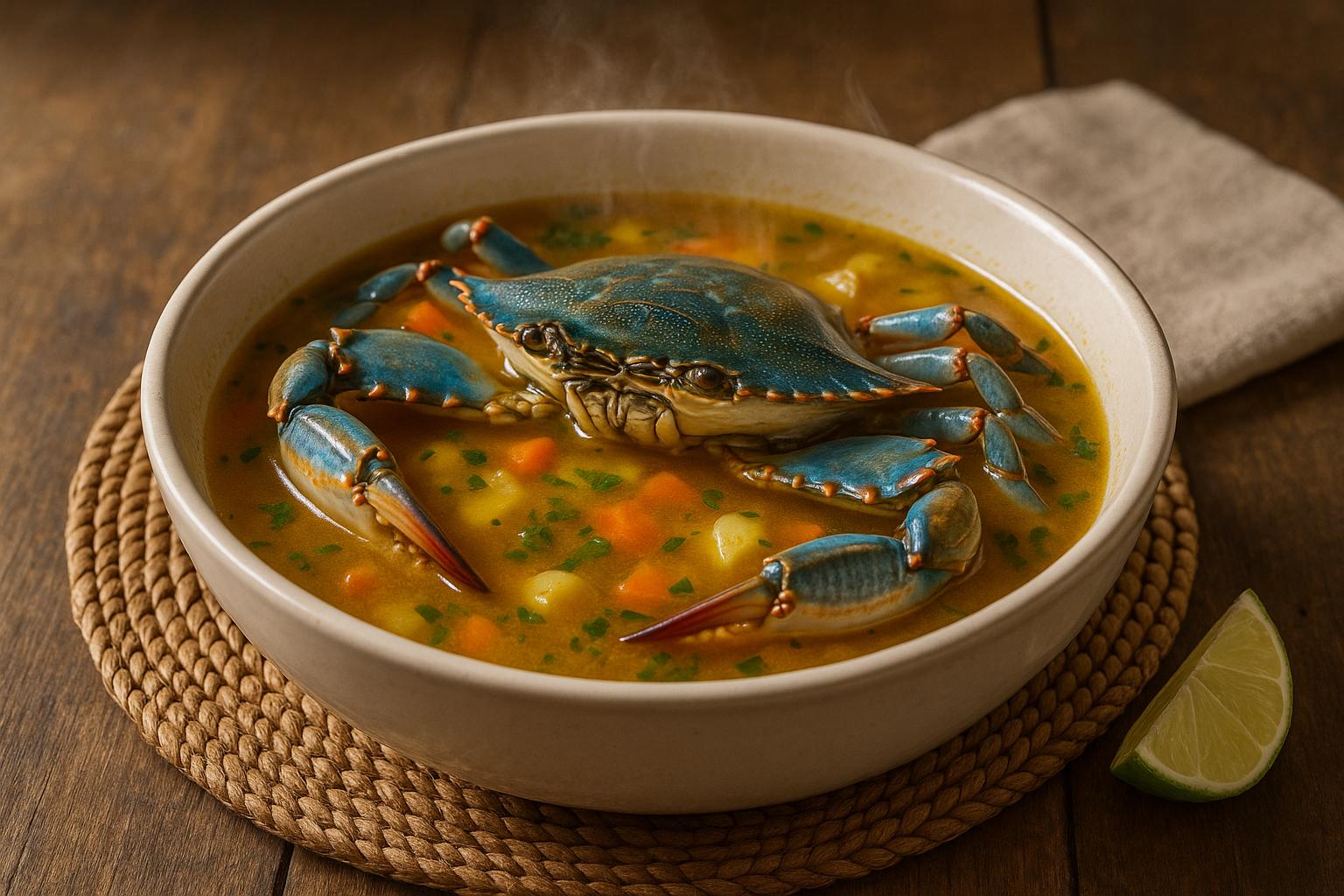Haitian Carnival beignets (Benyen kanaval) are banana-based fried treats enjoyed during Haiti's Carnival season. Unlike New Orleans-style beignets, these are flat, dense, and crispy, with natural sweetness from ripe bananas and warm spices like cinnamon and nutmeg. They’re quick to make using simple ingredients like bananas, flour, sugar, and baking soda, without the need for yeast or rising time. Fry them in hot oil, sprinkle with granulated sugar, and serve warm for a festive snack or dessert.
Key Steps to Make Haitian Beignets:
- Mash overripe bananas until smooth.
- Mix dry ingredients (flour, baking soda, spices) and combine with the banana mixture.
- Fry spoonfuls of batter in hot oil (350°F–370°F) until golden.
- Drain and sprinkle with sugar before serving.
These beignets are a Carnival favorite, symbolizing joy and celebration, and are best enjoyed fresh with coffee or Haitian Kremas.
Ingredients and Equipment You'll Need
Key Ingredients for Best Flavor
The secret to authentic Haitian Carnival beignets? Ripe bananas. As Savory Thoughts puts it:
"Unlike any other beignets you've tasted, these Haitian Beignets are prepared with a slightly different technique. Instead of having the flour as the base of the beignets, the base of our beignets are ripe bananas." [1]
For the best results, use bananas that are overly ripe with plenty of brown spots. They’re naturally sweeter and easier to mash. If your bananas aren’t quite there yet, you can speed up the ripening process by popping them in the oven. While fig bananas are traditional in Haiti, regular bananas are an excellent alternative.
For the dry mix, you’ll need all-purpose flour, granulated sugar, and baking soda. The baking soda helps the batter rise and gives the beignets a denser texture. To capture that authentic Caribbean essence, add warm spices like cinnamon and nutmeg, and for an extra layer of flavor, stir in a splash of vanilla or almond extract.
The liquid ingredients can vary depending on the recipe. Some call for milk and eggs or evaporated milk for a richer batter, while others stick to water and skip the eggs entirely. If you want to add a little extra Caribbean flair, consider mixing in a touch of rum or a sprinkle of lime zest.
Once you’ve prepped your ingredients, it’s time to gather the tools that will bring it all together.
Kitchen Tools You'll Need
To nail the texture and flavor of Haitian Carnival beignets, you’ll need just a few basic kitchen tools.
Grab a large mixing bowl and a fork or potato masher to mash the bananas. Use measuring cups and spoons to get the proportions just right. For frying, a heavy-bottomed skillet or cast-iron pan works best to maintain consistent heat.
You’ll also need tongs or a slotted spoon to flip the beignets and transfer them out of the oil. Prepare a cooling rack or a paper towel-lined plate to drain any excess oil. Finally, a ladle or large spoon will help you portion the batter evenly.
With these ingredients and tools in hand, you’re all set to whip up a batch of Haitian Carnival beignets and enjoy a taste of tradition right in your own kitchen.
How to Make Haitian Carnival Beignets
Making the Batter
Start by mashing your overripe bananas until they’re smooth. As Savory Thoughts advises:
"Make sure your bananas are beaten until smooth, and your batter is well mixed. This will ensure the beignets cook evenly throughout when fried." [1]
In another bowl, mix your dry ingredients: flour, baking soda, salt, cinnamon, and nutmeg. These spices are what give Haitian beignets their signature Caribbean flavor.
Now, take your mashed bananas and combine them with sugar, vanilla extract, and your choice of liquid - whether it’s milk, evaporated milk, or water. Mix everything thoroughly before gradually folding in the dry ingredients. Tchakayiti shares this insight:
"Though there are some recipes that call for banana chunks, our traditional beignet recipe calls for mashed ripe bananas and a lot of sweet spices and vanilla." [2]
The batter should have a consistency similar to thin pancake batter - not too thick, not too runny. If it feels too dense, add a splash of liquid. If it’s too thin, sprinkle in a bit more flour. Once your batter is ready, it’s time to fry them to golden perfection.
Frying the Beignets
Heat oil in a heavy-bottomed skillet or cast-iron pan to a temperature between 350°F and 370°F. Using a deep-fry thermometer is key to getting that crispy, golden exterior without leaving the beignets greasy.
To test if the oil is ready, drop a small spoonful of batter into the pan. It should float and bubble within two seconds. If it sinks or doesn’t bubble, the oil needs more time to heat up.
Fry the batter in small batches, dropping spoonfuls gently into the oil. Don’t overcrowd the pan, as this can lower the oil temperature and affect the texture.
Flip the beignets frequently - every 20 seconds or so - to ensure they brown evenly on all sides. They’ll puff up and turn golden brown in about 2 to 3 minutes per batch.
Keep an eye on the oil temperature, adjusting the heat as needed. If it’s too hot, the outside will burn before the inside cooks through. If it’s too cool, the beignets might soak up too much oil.
Draining and Serving
Once the beignets are perfectly fried, use a slotted spoon to remove them from the oil and place them on paper towels to drain.
While they’re still warm, dust them with sugar. You can use granulated sugar for a slight caramelized crunch or powdered sugar for a smoother, even coating. Unlike the powdered sugar-heavy New Orleans-style beignets, Haitian beignets are often finished with granulated sugar.
Serve them right away while they’re warm and crisp. They’re an excellent companion to coffee, tea, or a glass of Haitian Kremas for a festive touch.
If you need to keep them warm while frying additional batches, place the cooked beignets on a wire rack in a low oven (around 200°F) for a short time. This ensures they stay warm without losing their crispness.
Haitian Benyen (Beignet De Carnaval) - Episode 59 - ❤ Love For Haitian Food
sbb-itb-80c33ff
Tips for Perfect Texture and Flavor
Once you’ve mastered the basics, these tips can help you troubleshoot common issues and experiment with creative twists to refine your beignets.
Fixing Common Problems
If your beignets turn out soggy or greasy, it’s likely due to the oil temperature dropping too low. Keep a thermometer on hand and maintain the heat between 325°F and 350°F while frying [1]. Beignets that don’t puff up immediately are another sign that your oil isn’t hot enough [5].
Dense or heavy beignets might be the result of overmixing the batter or not mashing the bananas thoroughly. The batter should flow easily off the spoon [1]. If they still don’t puff up properly, try spooning some hot oil over the tops while the bottoms fry - this can help achieve that light, airy texture [5].
To avoid excessive oil absorption, drain your beignets as soon as they come out of the fryer. Letting them sit in the oil too long can ruin the texture [1].
Once you’ve nailed the texture, it’s time to get creative with flavors.
Flavor Variations and Add-ins
Traditional Haitian beignets are flavored with sweet spices and vanilla [2], but they’re incredibly versatile. A tablespoon of rum can add a subtle depth of flavor and moisture without overpowering the beignets [3].
For a tropical twist, try mixing lime zest into the batter [3]. Almond extract is another option - just use about half the amount of vanilla extract you’d typically add [1].
Feel free to play around with your spice mix. While cinnamon and nutmeg are the go-to choices, adding a pinch of ginger can bring a touch of warmth. Adjust the spice ratios to suit your taste [6][1]. Using darker, overripe bananas will naturally sweeten the beignets, so you may need to cut back on added sugar [1].
Some cooks swap water for milk in the batter to create a richer, more tender texture. The subtle dairy notes from this substitution pair beautifully with the spices [2][6].
How to Serve Haitian Beignets
Once your beignets are perfectly fried and flavored, serving them fresh is key. They’re best enjoyed warm, ideally right after frying, with a light dusting of granulated sugar to add a delicate crunch.
Pair them with coffee for a classic combination - the bitterness of the coffee balances the sweetness of the beignets. For a festive touch, serve them alongside Haitian Kremas, a creamy coconut-based holiday drink that complements the tropical flavors.
Haitian beignets also make an excellent addition to a Carnival spread. Serve them with other traditional Haitian desserts or as a special breakfast treat alongside strong Haitian coffee. They’re satisfying enough to stand alone but light enough to enjoy as an afternoon snack.
For those looking to explore more of Haiti’s culinary traditions, HaitianFoods.org is a great resource. It features a directory of restaurants offering authentic dishes and provides insights into the foods that make Haitian Carnival celebrations so memorable.
Learning About Haitian Beignets and Cuisine
Delving into the story of Haitian beignets offers a glimpse into centuries of tradition, revealing why these treats hold a cherished place during Carnival season.
History and Meaning of Beignets
Haitian beignets carry a fascinating history shaped by a mix of influences. Unlike their French counterparts, these banana-based delights reflect how Haitian cooks adapted European techniques to incorporate local ingredients [4]. Interestingly, the word "beignet" has roots in the Celtic word "bigne", which means "to raise" [9]. However, Haitian beignets have evolved into something entirely distinct, embodying the creativity and resourcefulness of Haitian cuisine.
What makes them truly special is their deep connection to Carnival, or Kanaval, celebrations. These treats are almost exclusively enjoyed during this festive season [4], making them a hallmark of one of Haiti's most vibrant traditions. During Carnival, street vendors fill the air with the enticing aroma of freshly fried beignets, a tradition passed down through generations.
But these treats go beyond just flavor - they serve as a bridge to Haitian culture. For instance, in February 1990, Liliane Nérette Louis, a Haitian American storyteller and cook, prepared traditional Haitian beignets in Miami, Florida, showcasing how these beloved snacks continue to connect communities, even far from home [7]. Every bite of a Haitian beignet is a celebration of heritage and innovation. If you’re curious, exploring local dining options is a great way to experience this tradition firsthand.
Finding Real Haitian Beignets
Want to taste authentic Haitian beignets? Discovering them locally can deepen your appreciation for this culinary tradition. If making them at home isn’t an option, there are plenty of ways to find genuine Haitian cuisine near you. One great resource is HaitianFoods.org, a directory that connects food enthusiasts with authentic Haitian restaurants around the globe. The site features detailed listings, descriptions of traditional dishes, and insights into Haitian culinary traditions.
If you’re in the Metro Atlanta area, you’re in luck. Restaurants like Jojo Fritay Haitian Cuisine and Zeke's Kitchen & Bar are well-known for their authentic Haitian offerings, including options for dine-in, delivery, or catering [8].
Another great opportunity to explore Haitian food culture is during Haitian Restaurant Week, where participating restaurants and food trucks in various cities showcase the richness of Haitian cuisine. Seasonal specialties like Carnival beignets often take center stage during this celebration.
For the most authentic experience, look for beignets made with fig bananas - they give the perfect texture that’s crunchy on the outside, setting them apart from the softer New Orleans-style beignets [3]. Whether you find them at a local restaurant or during a festival, Haitian beignets promise a flavorful connection to a rich cultural tradition.
Conclusion
Making Haitian Carnival beignets at home is easier than you might think, especially when you stick to a few key steps. The trick to getting that perfect golden brown is keeping your oil temperature steady between 325°F and 350°F. Drop spoonfuls of batter into the hot oil, fry until they’re beautifully golden, and then let them drain on paper towels. While they’re still warm, coat them generously with granulated sugar for that final touch. This simple process brings a taste of Haitian tradition right into your kitchen.
These banana-based treats stand apart from the more familiar New Orleans beignets. Instead of using flour, mashed bananas form the base, giving them their distinct flavor and texture. As Chef Stephan Berrouet Durand, founder of the Haitian Culinary Alliance, explains:
"I get to share my cuisine with the world. To have someone come and inform me, 'Oh, I've been to that Caribbean nation. I remember this,' that touches your soul."
Bringing this tradition to life in your own kitchen is more than just cooking - it's about celebrating a piece of Haitian heritage. As Haiti Wonderland’s Jeunes Influenceurs puts it:
"Instead of lamenting the traditions that are disappearing, let's recreate some memories in your kitchen during this festive season by making beignets! 'Benyen kanaval'!"
Serving these beignets is a delicious way to honor the vibrant spirit of Haitian Carnival and connect with a celebration that has been cherished for generations.
FAQs
How can I make my Haitian Carnival beignets crispy and not greasy?
To get perfectly crispy Haitian Carnival beignets without the greasy texture, make sure your oil is heated to 370°F before frying. Stick to neutral oils like vegetable or cottonseed oil, as they help create that golden, crunchy exterior while preventing the beignets from absorbing too much oil.
Another tip: don’t overcrowd the pan. Fry the beignets in small batches to keep the oil temperature steady. If you add too many at once, the oil cools down, and you’ll end up with soggy beignets instead of the light, crispy treats everyone craves. Keeping the oil at the right temperature is the secret to success!
Can I use something other than ripe bananas for Haitian Carnival beignets?
If you’re out of ripe bananas, don’t worry - you’ve got options! You can use mashed sweet potato or unsweetened applesauce as substitutes. Mashed sweet potato is the best match since it offers a similar level of sweetness and moisture. Applesauce works too, but you might need to cut back on other liquids in your recipe to keep the texture just right.
While these swaps might tweak the flavor and texture of your beignets a bit, they’ll still turn out tasty!
How can I customize Haitian Carnival beignets while keeping their authentic flavor?
To give Haitian Carnival beignets your own flair while keeping their traditional taste intact, try mixing mashed ripe bananas into the batter. This adds a natural hint of sweetness and a fun twist. For toppings, you can stick with powdered sugar or go for something extra indulgent by drizzling sweetened condensed milk on top. These simple tweaks let you get creative while preserving the cherished essence of this classic treat.


